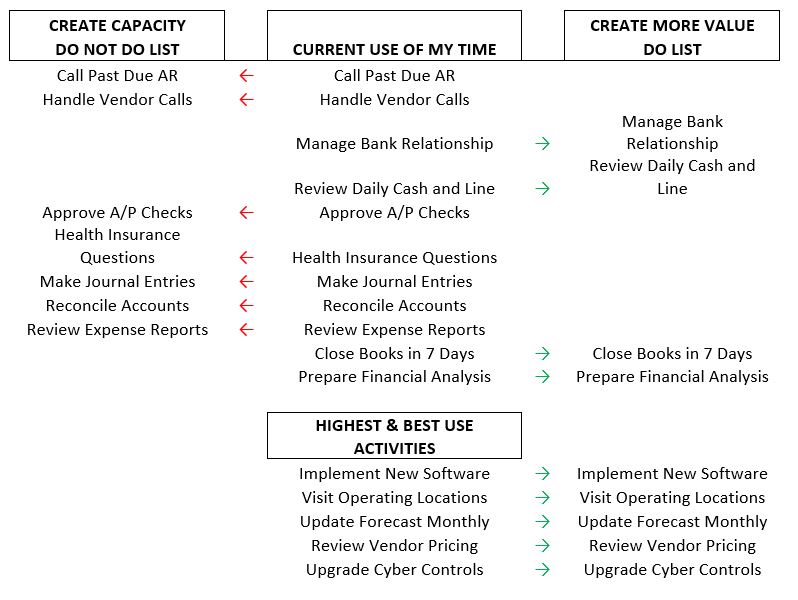In Part 1 of this article, we made the case that we often spend too little time focusing on how we spend our time in management or executive roles at our companies and this lack of focus can have a profound effect on our companies and our careers.
We posed the central question of how to get the highest and best use of your time so you add the most value to the company in exchange for your compensation. We also discussed the options to free your time which are to 1) eliminate, 2) delegate, or 3) automate.
This all sounds great, but how do you go about actually doing it?
Tick Tock.
I have been following the below process for many years. It takes constant attention, discipline, and focus, but it is doable and the effect can be profound. I suggest that you follow this 4-step process twice per year and write it down so you can review progress and make changes.
- Determine the Highest and Best Use of Your Time
- Identify your strengths within your skillset and think about how you can do more of those things. Working within your strengths is usually easier work and more fun to do
- Think about taking a skills inventory through an assessment such as the Predictive Index or DISC Profile. This will give you more self-awareness of your where your skills are likely to be the most beneficial
- When you look at your role in your company, determine if there are higher-level things that you could be doing and that you are capable of doing but just don’t have the time to get to
- In making this list, think about where you want to be in five years, the role you want to progress to, the work you want to be doing, and the skills you want to have
- Make a list of the these “Highest and Best Use Activities” that you should be spending most of your time on at your company
- Make a “Current Task List” of Everything you Spend Time on at Work
- Create this list and add to it over a period of a weeks or a month to make sure you capture all the things that you work on and that occupy your time
- Make the list comprehensive and include everything you spend time on at work in your current responsibilities
- Make a “Do Not Do” List
- Identify all the things on your “Current Task List” that are not part of your “Highest and Best Use Activities”
- Determine if these items can be 1) Eliminated, 2) Delegated, or 3) Automated
- Develop a plan/timeline to get these non-value-added tasks off your plate
- Make a “Do” List
- The “Do” list should comprise only those things that are part of your “Highest and Best Use Activities” and should come from two sources:
- Those existing tasks that you have been spending time on that are important and you should continue to do
- New tasks and activities that are more value-added work that are consistent with your “Highest and Best Use List”
- Set a timeframe to create capacity to reallocate your time to your highest and best use activities
- The “Do” list should comprise only those things that are part of your “Highest and Best Use Activities” and should come from two sources:
I do this exercise once per year and revisit my progress several times each year.
Tick Tock.
Here is an example of how this four-step process could look in a finance role:

The Long-Term Compounding Effect
There is an immediate benefit from focusing your time on higher-value work. It feels better to contribute at higher level. However, the real benefit is the compounding effect of doing this exercise over a long period of time because your value-added work will compound over time. Interest is not the only thing that compounds. Compounding is a universal law, and pushing yourself to become better and contribute more over a long period of time will have a dramatic effect on your company, your happiness, and your career.
Having done this for a long time, I have learned that, like most things, I get better at it the more I practice it. It is not easy and requires a combination of vision, thoughtfulness, and discipline. The most important thing is to act, and to start now, because you can’t have the time back.
Tick Tock.

